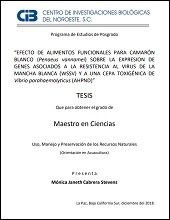Efecto de alimentos funcionales para camarón blanco (Penaeus vannamei) sobre la expresión de genes asociados a la resistencia al virus de la mancha blanca (WSSV) y a una cepa toxigénica de Vibrio parahaemolyticus (AHPND)
Texto completo PDF:
Autor
MONICA JANETH CABRERA STEVENS
Metadatos
Mostrar el registro completo del ítemResumen
"El camarón blanco Penaeus vannamei es un recurso acuícola importante por su valor económico y por el incremento de la práctica de su producción en la última década. Sin embargo, es afectado por enfermedades en los cultivos como el virus del síndrome de la mancha blanca (WSSV) y la bacteria Vibrio parahaemolyticus toxigénica causante de la necrosis hepatopancreatica aguda (AHPND). Una manera de mejorar el estado de salud y resistencia a enfermedades del camarón es por medio del perfeccionamiento de los alimentos tradicionales, abriendo paso a los alimentos de nueva generación o “funcionales” los cuales se han implementando en la ciencia en busca de efectos benéficos que ayuden a mejorar las condiciones del camarón blanco en su cultivo. En el presente estudio se probaron ocho distintos alimentos considerando los requerimientos nutricionales del camarón blanco P. vannamei, de los cuales un alimento se elaboró con la formula convencional o referencia (Ref); a seis se les agregaron ingredientes funcionales: 1- Alimento simbiótico que contiene probiótico y prebiótico (Sim), 2- extracto de tres algas Ulva sp., Eisenia sp. y Porphyra sp.(Alga), 3- mayor cantidad de lo requerido de vitamina C (VitC), 4- -glucanos (-glu), 5- arginina (Arg), 6- mezcla de plantas cúrcuma y maca (CuMa); y finalmente un alimento con deficiencia en ácidos grasos altamente insaturados como control suceptible(DefAG). Estos alimentos fueron administrados a camarones en condiciones controladas de laboratorio durante 28 días, obteniendo que los camarones alimentados con CuMa, VitC y Sim fueron los que mejor rendimiento mostraron en el bioensayo de crecimiento, obteniendo diferencias significativas entre los distintos alimentos con valores de p menores a 0.05 para ganancia de peso, consumo, tasa de crecimiento y factor de conversión alimenticia. Por el contrario, los camarones alimentados con la dieta DefAG tuvieron el menor rendimiento en los parámetros evaluados. En un segundo ensayo, camarones alimentados durante 28 días con los ocho alimentos fueron retados con el virus WSSV y con la bacteria VpAHPND, obteniendo que los camarones infectados con WSSV y alimentados con CuMa presentaron el mayor porcentaje (60%) de supervivencia a las 72 h, a diferencia de los DefAG, -glu y Ref con un 0% de supervivencia en el mismo periodo..." "The whiteleg shrimp Penaeus vannamei is an important aquaculture resource due to its economic value and the increase in their production in the last decade. However, the culture it is affected by diseases such as the white spot syndrome virus (WSSV) and the toxigenic strain of the bacteria Vibrio parahaemolyticus that causes acute hepatopancreatic necrosis (AHPND). A way to improve the state of health and resistance to diseases of shrimp, is through the improvment of conventional feed, by opening the way to a new generation or "functional" feeds which have been implemented lately fucused in beneficial effects that help to improve the culture conditions of the white shrimp. In the present study, eight different feeds were tested considering the nutritional requirements of the white shrimp P. vannamei: one feed was elaborated with the conventional formula used as reference (Ref); six functional feeds including 1- a symbiotic that contains probiotic and prebiotic (Sim), 2- extracts of three algae Ulva sp., Eisenia sp. and Porphyra sp. (Alga), 3- extra amount of vitamin C required (VitC), 4- β-glucans (β-glu), 5- arginine (Arg), 6- mixture of turmeric and maca plants (CuMa); and finally a feed with deficiency in highly unsaturated fatty acids as suceptible control (DefAG). These foods were administered to shrimp under controlled laboratory conditions for 28 days, obtaining that the shrimp fed with CuMa, VitC and Sim were those that showed the best performance in the growth bioassay, obtaining significant differences between the different feeds (p<0.05) for weight gain, feed consumption, growth rate and feed conversion rate. As expected, the shrimp fed with the DefAG diet had the lowest performance in the evaluated parameters. In a second bioassay, the shrimp fed during 28 days with the eight foods were challenged with the WSSV virus and the VpAHPND bacteria, obtaining that the shirmp infected with WSSV and fed with CuMa had the highest percentage (60%) of survival at 72 h, unlike the DefAG, β-glu and Ref with 0% survival in the same period. With respect to the challenge of shrimp infected with VpAHPND, specimens fed with CuMa and VitC diets had the highest survival (85%) in 120 h, in contrast to those fed with the DefAG diet, which obtained 10% survival..."
Colecciones
Ítems relacionados
Mostrando ítems relacionados por Título, autor o materia.
-
PROMOCIÓN DEL PERIFITON PARA EL CULTIVO DE CAMARÓN BLANCO: HACIA UNA ACUICULTURA ECOLÓGICA
DOMENICO VOLTOLINA LOBINA; JUAN MANUEL AUDELO NARANJO; MARIA DEL ROSARIO PACHECO MARGES -
Suelo y Erosión
YOLANDA LOURDES MAYA DELGADO


